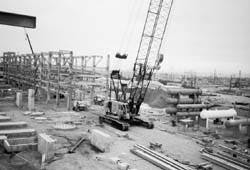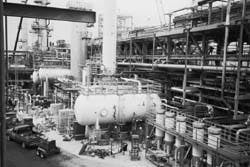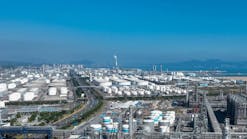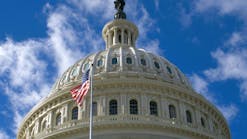Anne K. Rhodes
Refining/Petrochemical Editor
Construction of a 48,000 b/d gas oil hydrotreater was the discretionary portion of Ultramar Inc.'s clean fuels project. Cannibalization of existing equipment from another refiner's canceled project saved Ultramar $25-30 million and compressed the construction schedule by 8 months. Shown here is construction of the unit in April 1995 (left) and July 1995 (right).Ultramar Inc. has completed a $300 million upgrade of its refinery at Wilmington, Calif., near Los Angeles. The three-step program enables the refinery to produce reformulated gasolines meeting federal and California standards.
The upgrade was done in three steps:
- Step 1 included a new naphtha hydrotreater (NHT) for sulfur reduction and a splitter for benzene reduction. These additions enabled Ultramar to produce the reformulated gasoline (RFG) required by the U.S. Environmental Protection Agency (EPA) beginning in January 1995. The naphtha hydrotreater started up in September 1994.
- Step 2 included an olefin treater for gasoline from the fluid catalytic cracking (FCC) unit (cat gasoline), a hydrotreated naphtha rerun tower, and modifications to the FCC unit (FCCU) main fractionator and debutanizer. To support the changes made in Steps 2 and 3, Ultramar expanded utilities, sulfur handling, and hydrogen production facilities during Step 2. The Step 2 modifications, commissioned in February of this year, allowed the refinery to produce the RFG required by the California Air Resources Board (CARB) beginning Mar. 1.
- Step 3 comprised a new, 48,000 b/d gas oil hydrotreater (GOH) which started up in mid-March. This was a discretionary project driven by an expected return on investment. Step 3 enabled Ultramar to produce more alkylate, which John Miller, general manager of engineering and support services for Ultramar, calls "the ultimate clean fuel."
Project planning
Ultramar was one of only two California refiners to publicly support CARB's Phase 2 RFG regulation. The other was ARCO.
Table 1 [39971 bytes] shows the specifications for federal and CARB RFG.
Ultramar began planning the clean fuels project when CARB passed its RFG regulation. An early start was necessary because of the extensive review process required in California.
Four major permits were required:
- A California Environmental Quality Act project review and environmental impact report
- A South Coast Air Quality Management District (Scaqmd) permit-to-construct review
- A California Coastal Commission coastal development permit (Ultramar's is the only refinery in Southern California within the coastal boundary.)
- A zoning variance for one tower because of local height restrictions.
Obtaining these permits sequentially would have required about 30 months for each project step, according to Jason Lee, senior environmental engineer for Ultramar (Fig. 1 [28084 bytes]). Considering the additional time required to construct the units, it was clear that sequential permitting would not enable Ultramar to meet the regulatory deadlines for producing reformulated fuels. To solve this problem, Ultramar made use of the parallel review process.
Obtaining the construction permits was an arduous process because of the number of units involved. Ultramar held 9 public hearings and 13 public reviews and notices; made 2 environmental impact determinations; and obtained 40 permits-to-construct, 5 coastal development permits, and 1 zoning variance.
Using parallel review, the company was able to compress the schedule. In fact, permitting for each step was reduced to 10 months. In the end, all units started up on or ahead of schedule.
"We were the first refinery to obtain all the permits," added Lee, "even with the extra layers of coastal review. That allowed us to be the first refinery to produce a commercial quantity of California reformulated gasoline."
The expansion
Although Ultramar describes the project as a series of three steps, there was much overlap.
"We realized a significant cost savings from running these projects simultaneously," said J.W. (Bill) Haywood, director of the clean fuels projects and now general manager of production.
The following sections describe the details of each stage.
Step 1
The first phase of Ultramar's clean fuels project prepared the refinery to produce EPA RFG. The obstacle to producing this fuel at the Wilmington plant was reducing gasoline benzene to less than 1 vol %.
To overcome this barrier, Ultramar added a 24,000 b/d straight-run naphtha hydrotreater in Step 1 of the expansion (Fig. 2 [37254 bytes]).
Included in Step 1 was a splitter to prefractionate reformer feed. This unit separates the benzene precursors from the naphtha feed and routes them around the reformer to gasoline blending.
Ultramar's original plans called for addition of a benzene-removal unit. But because the refinery processes crudes that are not high in benzene, further processing steps, such as saturation or isomerization, were determined to be unnecessary.
Prefractionation and splitting have reduced reformate benzene to less than 1 vol % from about 5 vol %.
Additional modifications were performed during Step 1:
- A former coke pond was filled in and used as the plot for the new naphtha hydrotreater
- A railroad was relocated to make space for the gas oil hydrotreater built during Step 3.
Step 2
The second phase of the clean fuels project added an olefin and sulfur treater for cat gasoline, licensed by Institut Français du Petrole (IFP). The existing naphtha hydrotreater was converted for this purpose. The conversion included the addition of diluent recycle and liquid quench.
"The NHT investment in Step 1 set us up for Step 2," said Haywood. According to William Bodnar, process manager for clean fuels and now manager of production optimization, the existing 15,000 b/d naphtha hydrotreater was the right size to be converted to a cat gasoline hydrotreater.
Reusing existing equipment decreased the capital cost of the olefin treater. Greg Hass, Ultramar's manager of planning and economics, says converting an existing unit reduced downtime because the new naphtha hydrotreater was on stream already.
Between the splitter and reformer, a new rerun tower was added to split out the heavy portion of the naphtha. This tower has helped Ultramar produce CARB gasoline, says Bodnar, by reducing the 90% distillation point (T90) of reformate and cat gasoline to 310-320° F. from about 380° F.
Ultramar modified some existing units during Step 2:
- Pumparounds and cooling were added to the FCCU main fractionator. These changes have shifted the heat balance of the column considerably, according to Bodnar, and enabled Ultramar to reduce the cat gasoline T90.
- The debutanizer was retrayed. The improved fractionation enables Ultramar to control the cat gasoline Rvp.
Step 3
The third stage of the refinery expansion was the addition of a 48,000 b/d, high-pressure gas oil hydrotreater and associated amine contactor.
Another West Coast refiner designed this unit in the early 1990s and procured its major equipment. After procurement, the refiner elected not to proceed with the project and sold the equipment to a Gulf Coast refinery. Rather than use the hardware, this second refiner sold it to Ultramar, saving Ultramar an estimated $25-30 million and compressing the completion schedule by 8 months compared to a grassroots unit.
Air Products & Chemicals Inc. added 80 MMscfd of hydrogen capacity at the Wilmington refinery.
Through an across-the-fence supply agreement, Air Products supplies the hydrogen used in the gas oil hydrotreater (about 40
MMscfd).
The UOP Platformer supplies enough hydrogen to feed the naphtha hydrotreater, olefin treater, and Butamer isomerization unit.
Step 3 also involved reconfiguring an existing 36,000 b/d Unibon unit-a gas oil/middle distillate hydrotreater-to enable turndown to about 18,000 b/d. Feed to the unit is now distillate in the jet/diesel range.
Before these changes were made, Ultramar was purchasing hydrotreated gas oil to use as FCC feed. Since starting up the new hydrotreater, the refinery now purchases only raw gas oil.
The processing changes have affected stream qualities in a number of ways:
- The sulfur content of the refinery's FCC feed has decreased to 0.08-0.09 wt % from 0.2 wt %.
- The sulfur content of finished gasoline is less than 40 ppm, compared to about 150 ppm before the project.
- Deep denitrification of the gas oil has improved FCC conversion by 7-8 vol %.
In addition, the new units enable the refinery to produce 100% CARB RFG. (Ultramar uses purchased MTBE for RFG blending.)
The third phase of the clean fuels project also beefed up the refinery's utilities-including steam, process water, and electricity. Sulfur handling capability also was increased.
Sour water stripping capacity was increased by 450 gpm. And the boiler feedwater and condensate systems were debottlenecked.
The existing sulfur plants had a combined capacity of 180 long tons/day. These units use oxygen enrichment to maximize capacity. The addition of recycle blowers and a 900-gpm amine regeneration unit increased capacity of the sulfur units to 250 long tons/day.
Other elements in the Step 3 modifications included:
- Debottlenecking the LPG-to-alkylate process to increase alkylate production by 20%. Key factors in achieving this increase were a new deisobutanizer and increased FCC conversion.
- Increasing cooling water to the alkylation unit.
Originally, Step 3 called for the addition of an aromatics saturation unit. Ultramar obtained the permits for this unit, but pilot tests did not indicate the expected improvements.
"The long-term market forecast doesn't really support our making those modifications right now," said Hass.
Other changes
The clean fuels project also included two new 150,000-bbl storage tanks for CARB gasoline. Another tank was added for sulfur storage. The sulfur is pumped from the existing pits to the tank.
In addition, a new in-line gasoline blending system was installed. The refinery's existing blending system could not deliver the precision required to assure compliance with the multiple CARB specifications.
The new blending system uses on-line near infrared analyzers to measure octane, aromatics, olefins, and oxygen content.
Project impacts
The Wilmington refinery was designed to process crude oils from the Los Angeles basin. With the decline in production of Alaska North Slope crude, and other changes in the West Coast crude balance, the refinery's crude slate has broadened to include crudes from Latin America, the Middle East, and the Far East.
The clean fuels upgrade has enabled Ultramar to be more flexible in its crude selection-so flexible, in fact, that Ultramar representatives say there is no typical crude slate.
Before the expansion, crudes were combined to produce a blend with an API gravity of about 22° and a sulfur content of 1.5-2.0 wt %. While Ultramar has not altered the gravity of its crude blends since the upgrade, it has increased the sulfur content of its crude slate to 2.0-2.5 wt %.
Another effect of the upgrade is reduced variation in FCC feed quality, resulting from the added gas oil hydrotreating capacity. This, says Bodnar, will give Ultramar greater opportunity to optimize its FCC catalyst.
In addition, because the naphtha T90 is reduced, that stream is reformed more easily. This means coke make is decreased, which leaves excess coke-burning capacity. These changes in the naphtha processing scheme will enable Ultramar to decrease reformer pressure and, as a result, increase reformate yield.
The clean fuels project has broadened Ultramar's processing options. For example, the plant can now blend cycle oil into diesel, increase alkylate production, or hold alkylate output steady while adding an oxygenate to the gasoline mix.
Emissions
As a result of the new units, Ultramar's regulatory reporting requirements have increased. Partly responsible for this increase is the addition of three heaters-two for the naphtha hydrotreater and one for the gas oil hydrotreater.
The two naphtha heaters share a stack, so two stacks were added in the upgrade. Both stacks are equipped with selective catalytic reduction to decrease NOx emissions.
Continuous emissions monitoring systems test the stacks constantly for emissions, as required by the South Coast Air Quality Management District under its Regional Clean Air Incentives Market (Reclaim) program.
Testing requirements for fugitive emissions also have increased since the new units were brought on-line. Scaqmd's Rule 1173, governing such emissions, requires Ultramar to test all new units monthly (existing units are tested quarterly). Because the naphtha hydrotreater has demonstrated a low leak rate, Scaqmd has allowed Ultramar to reduce the testing frequency on that unit to once per quarter.
Economics
Although a detailed economic analysis of the third and discretionary step is not yet available, Ultramar considers it a great success. The hurdle rate for this part of the project is 15%, according to Miller.
Steps 1 and 2, which allowed Ultramar to produce, respectively, EPA and CARB RFG, were considered nondiscretionary expenditures. For this reason, return on investment for these steps is a function of the selling price of CARB RFG.
"The synergy between the Step 1 and Step 2 modifications and the GOH has presented opportunities to optimize feedstock selection, refinery operation, and product slate and quality," said Miller. Examples of these benefits are: production of specialty distillates, increase in alkylate output, and upgrade of cycle oil to diesel.
"We expect our cash flow to improve by about $35 million/year for the gas oil hydrotreater," said Miller.
Copyright 1996 Oil & Gas Journal. All Rights Reserved.




